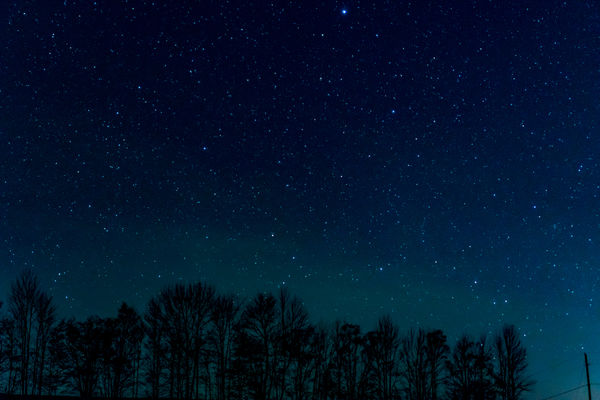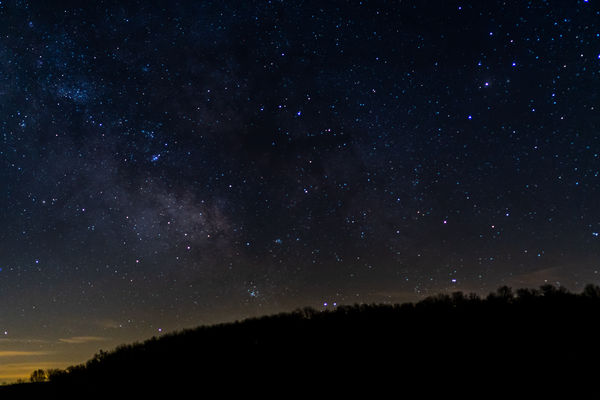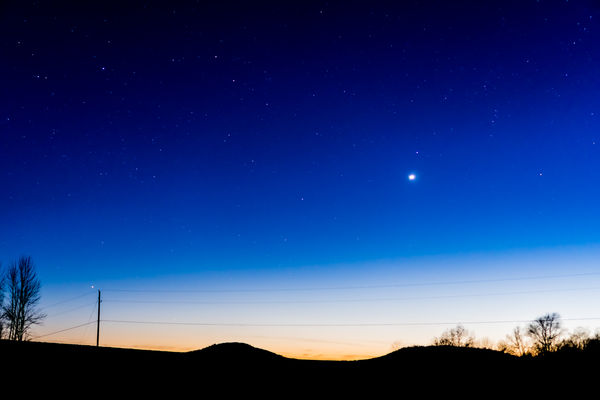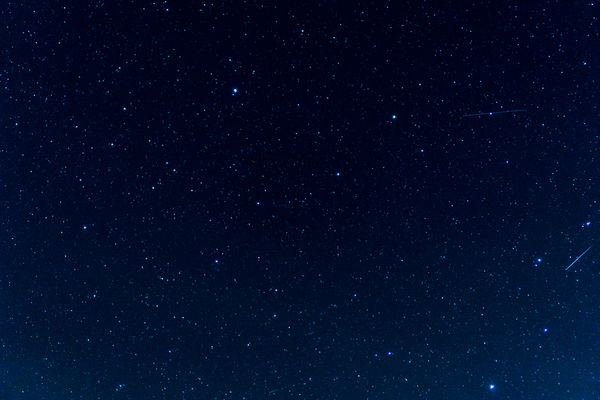Starting out - advice requested
May 23, 2020 01:45:50 #
Never tried any astro photography until recently. Have read through several of the guides here and in other places. I've managed to get a few shots that I like.
My biggest problem is camera movement. (Now that I think I have overcome the focus issue). Camera is set on a tripod and placed on the ground. I have the camera set up for an interval shoot with only one photo. The reason for this is it lets me set a delay... press the shutter button and there is a two-second delay before it starts taking the photo.
Even with this, many of my photos have "squiggles" that are due to camera movement. Any advice on how to eliminate the movement? The tripod is set low to the ground.
Attached are some "good" photos. The one photo with the powerlines running across was taken shortly after sunset - the horizon light is not light pollution. All were processed in Lightroom. Any suggestions for improvement are welcome.
My biggest problem is camera movement. (Now that I think I have overcome the focus issue). Camera is set on a tripod and placed on the ground. I have the camera set up for an interval shoot with only one photo. The reason for this is it lets me set a delay... press the shutter button and there is a two-second delay before it starts taking the photo.
Even with this, many of my photos have "squiggles" that are due to camera movement. Any advice on how to eliminate the movement? The tripod is set low to the ground.
Attached are some "good" photos. The one photo with the powerlines running across was taken shortly after sunset - the horizon light is not light pollution. All were processed in Lightroom. Any suggestions for improvement are welcome.
May 23, 2020 06:10:09 #
jrm21 wrote:
Never tried any astro photography until recently. ... (show quote)
Be sure your VR is off. Ofter it doesn't play well if the camera is on a tripod.
Terry
May 23, 2020 06:36:28 #
How stable is your tripod? Ideally, your center column should be down, all connections as tight as possible, and the rig should be weighted down, if possible. The quality and weight of the tripod can’t be overstated, however. I was using a “traveler” series Gitzo when taking photos of the moon, and not liking the results. I picked up on ebay a big mother of an old 5-series aluminum Gitzo, and i could not believe the improvement it made in my shots. Even if you find other areas to improve your photography, a goid tripod should always make thing better.
May 23, 2020 09:48:14 #
I've been using a smaller carbon fiber travel tripod. I thought it was pretty sturdy. Only extended the thickest legs, so it is very low to the ground. The center column was extended - didn't think that would be much of an issue. Everything seemed solid. I'll have to re-think this setup.
I have an old Gitzo 2220 - a real beast. Will give that a try with some weight.
Shooting with a Sony 6400. The body doesn't have stabilization, but the lens (35mm 1.8) does. Didn't realize that could have an effect. I'll turn that off.
Thanks to you both for the tips.
I have an old Gitzo 2220 - a real beast. Will give that a try with some weight.
Shooting with a Sony 6400. The body doesn't have stabilization, but the lens (35mm 1.8) does. Didn't realize that could have an effect. I'll turn that off.
Thanks to you both for the tips.
May 23, 2020 19:07:01 #
Ballard
Loc: Grass Valley, California
jrm21 wrote:
Never tried any astro photography until recently. ... (show quote)
Hi jrm21
If you are using a DSLR camera then when you start the shot the mirror going up can giggle the camera. For my imaging with a DSLR I always put it in live view so that the mirror is up before I start the exposure. In live view with a laptop attached most DSLR have a way to magnify the image that can really help you focus on a bright star.
May 24, 2020 02:04:05 #
Good points. I'm using a mirrorless (sony 6400), so the mirror flip isn't an issue. I also set a 2 second delay between the shutter button press and the start of the picture - no matter how careful, pressing the shutter button was causing a jiggle.
Focus is rough. My camera has magnification in the EVF when using manual focus. That and focus peaking did help a lot. It's still rough when in an area without much light pollution. Even a bright star is a tough focus target.
The lens is a focus by wire type, which didn't make things any easier. I got best results by setting manual focus, focusing on a distant object while it was still light out, and then waiting. One problem is that moving the program wheel on the camera (i.e. from Aperture priority to Manual) can reset the lens' focus point.
In the end, I think I have the focus problem fixed. As another poster pointed out, a sturdier tripod is likely to provide the biggest improvement for now. It doesn't seem to take much to create jiggly stars. :)
Focus is rough. My camera has magnification in the EVF when using manual focus. That and focus peaking did help a lot. It's still rough when in an area without much light pollution. Even a bright star is a tough focus target.
The lens is a focus by wire type, which didn't make things any easier. I got best results by setting manual focus, focusing on a distant object while it was still light out, and then waiting. One problem is that moving the program wheel on the camera (i.e. from Aperture priority to Manual) can reset the lens' focus point.
In the end, I think I have the focus problem fixed. As another poster pointed out, a sturdier tripod is likely to provide the biggest improvement for now. It doesn't seem to take much to create jiggly stars. :)
May 24, 2020 11:26:33 #
Ballard
Loc: Grass Valley, California
jrm21 wrote:
Good points. I'm using a mirrorless (sony 6400), s... (show quote)
The longer the focal length the easier it is to giggle. Also the stars move during the exposure.
This website talks about how long a picture you can take without guiding.
https://petapixel.com/2017/04/07/npf-rule-formula-sharp-star-photos-every-time/
May 25, 2020 00:47:45 #
Focus was and remains a bugger for me.
Can you try a longer delay than 2 seconds?
Also, I found that any movement can get transferred into your image.
I discovered that one night, by sitting perfectly still. Then by tapping my foot and seeing the difference.
When Ronnie (Stepping Beyond) mentioned about going to his "Bat Cave" in the basement, and remote imagining from there, I was on that like bee's on flowers. (Or flies on dog doo)
Ronnie helped me become a remote imager. And it solved all of the human motion disturbance.
Your images look very good as they are. And it takes a lot of time, and a lot of disappointments, but you are getting there.
It doesn't take a great deal of weight to improve stability of your tripod. I used to use my 11 pound Celestron counterbalance* hung with some heavy cordage and it helped stabilize my tripod. I got the tip from Dave in Vermont, who suggested 4 to 10 pounds.
You will also run across stone bags made to suspend from a tripod to put stones in for the expressed reason to stabilize and deaden unwanted movement.
*Despite the "One size fit's all" mentality, I needed ~9 pounds to counterbalance. So I made my own weights.
But the 11 pound weight worked as dead weight just hanging around.
Can you try a longer delay than 2 seconds?
Also, I found that any movement can get transferred into your image.
I discovered that one night, by sitting perfectly still. Then by tapping my foot and seeing the difference.
When Ronnie (Stepping Beyond) mentioned about going to his "Bat Cave" in the basement, and remote imagining from there, I was on that like bee's on flowers. (Or flies on dog doo)
Ronnie helped me become a remote imager. And it solved all of the human motion disturbance.
Your images look very good as they are. And it takes a lot of time, and a lot of disappointments, but you are getting there.
It doesn't take a great deal of weight to improve stability of your tripod. I used to use my 11 pound Celestron counterbalance* hung with some heavy cordage and it helped stabilize my tripod. I got the tip from Dave in Vermont, who suggested 4 to 10 pounds.
You will also run across stone bags made to suspend from a tripod to put stones in for the expressed reason to stabilize and deaden unwanted movement.
*Despite the "One size fit's all" mentality, I needed ~9 pounds to counterbalance. So I made my own weights.
But the 11 pound weight worked as dead weight just hanging around.

May 25, 2020 13:37:00 #
SonnyE wrote:
Focus was and remains a bugger for me. br Can you ... (show quote)
Don't let the hanging weight free swing! I like to use a sack of gravel, and I let part of its weight sit on the ground so it can't swing.
And use a remote shutter release.
May 25, 2020 13:41:44 #
jrm21 wrote:
Good points. I'm using a mirrorless (sony 6400), s... (show quote)
Focus by Wire always bugs me. I really prefer the old fashioned manual focus. Rokinon/Samyang are modern lenses with old fashioned manual focus.
And I only use a bright star to get close. Then switch to a really dim star and gently rock the focus back and forth watching for that dim star to become as bright as you can get it,
And turn off focus peaking. It interferes with the determination of a star being at its brightest. I only use focus magnification.
Most lenses are not good for stars when the aperture is wide open. They tend to show off all their distortion. And then as you stop down, you get star spikes. The tradeoff is only stop down enough to minimize the distortion and not so far as to grow spikes.
I never prefocus while it is light outside. That focus is not good enough for stars. Plus, as the air temperature drops, the focus changes.
I also dislike lenses that try to do me a favor by have infinity focus right at the end of travel for the focus ring. It is not possible to do a nice rocking around the best focal spot if all you can do is one side. And sometimes, you can't even reach the best focus point.
Many modern lenses that are manual focus aren't very easy to manually focus. The focus ring tends to have very little rotational travel and you just can't turn the focus ring precisely enough.
Also, there is no such thing as hyperfocal focus when it comes to stars. You cannot focus a little closer to keep something else in focus while keeping the stars in focus. Stars are greedy, and won't tolerate sharing focus with anything shorter than infinity.
Happy shooting.
May 25, 2020 14:05:05 #
Weights and counterbalance: More good points. Being on some very solid ground and no wind, I thought I would be okay. Switching to my heavy-duty tripod and some added weight (also anchored by the ground) seem like a good portion of the solution.
Remote shutter release: Agreed. My camera has a link to the phone which can be used as a live view and shutter release. For some reason, I couldn't get the two to connect the night I tried the above shots. That's why I switched to the intervalometer with a 2-second delay. It's connecting now, so I will definitely use the remote next time.
Focus tips: I never had a focus by wire lens in the past. Didn't know how much I wouldn't like it. I also use my camera for video (hobbyist) and do like the auto-focus tracking features. But when manual focus is desired, the old style is much preferred. I've been looking at lenses like the Rokinon 16mm T2.2 (which is manual focus only). Just have to decide how much use I can expect to get from a non-AF capable lens.
Focus Peaking: Thanks for the tip. I didn't realize that could be a detriment. I'll try your suggestions with the bright star/dim star method.
Again, thanks to everyone for the helpful ideas.
Remote shutter release: Agreed. My camera has a link to the phone which can be used as a live view and shutter release. For some reason, I couldn't get the two to connect the night I tried the above shots. That's why I switched to the intervalometer with a 2-second delay. It's connecting now, so I will definitely use the remote next time.
Focus tips: I never had a focus by wire lens in the past. Didn't know how much I wouldn't like it. I also use my camera for video (hobbyist) and do like the auto-focus tracking features. But when manual focus is desired, the old style is much preferred. I've been looking at lenses like the Rokinon 16mm T2.2 (which is manual focus only). Just have to decide how much use I can expect to get from a non-AF capable lens.
Focus Peaking: Thanks for the tip. I didn't realize that could be a detriment. I'll try your suggestions with the bright star/dim star method.
Again, thanks to everyone for the helpful ideas.
May 25, 2020 18:40:09 #
I started out with a wired release, then went to a wired intervalometer, but lost it in my stuff, so bought a wireless intervalometer. Definitely the best. (Then found the misplaced wired Intervalometer.)
I programmed it for delay, interval, and storage time. Worked great, and ran from inside the house so I could check it, and the cycling of my camera without approaching my mount.
No human induced ground vibrations around the mount or tripods.
Dis one
My dead weight was exactly that, a dead weight hanging free from my AVX center like Platypus balls.
It did not move, and did not swing. It was just a flexible dead weight absorbing and stabilizing my mount.
It made a great deal of improvement over with, or without, as far as my images were concerned. And the 11 pounds of Chinese cast iron was plenty enough.
It's a dampener, not an anchor.
I programmed it for delay, interval, and storage time. Worked great, and ran from inside the house so I could check it, and the cycling of my camera without approaching my mount.
No human induced ground vibrations around the mount or tripods.

Dis one
My dead weight was exactly that, a dead weight hanging free from my AVX center like Platypus balls.
It did not move, and did not swing. It was just a flexible dead weight absorbing and stabilizing my mount.
It made a great deal of improvement over with, or without, as far as my images were concerned. And the 11 pounds of Chinese cast iron was plenty enough.
It's a dampener, not an anchor.

If you want to reply, then register here. Registration is free and your account is created instantly, so you can post right away.





